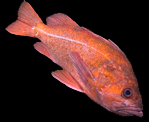
Shale Island
An island underwater? In a sense, this site's main feature is a mesa that protrudes above the surrounding bottom by a few feet at most points along its perimeter. The diversity of macro subjects here, particularly nudibranchs, is astounding. Even during daylight octopuses are frequently seen here. Sometimes they methodicly retreat into the nearest hole, but often they seem at least somewhat inquisitive, or, at least, content it just sit still long enough to wait out a diver's interest in them. Shale Island was also the location of my one and only encounter with a Stellar sea lion in the Monterey area. Stellars are big, REAL big. Also, unlike the California sea lions, Stellars seem inclined to hurt divers if you let them work up enough courage to do so. Divers who visit Yasha Island in Alaska's Frederic Sound, may, as I did, find themselves literally chased out of the water by Stellars who start by nipping and pulling fins, and work their way up to more aggressive acts like biting down on the crown of a divers head. I think much of their courage comes from being in large numbers. It's never the ones with whom you're making eye contact that are pulling off hijinks, but there are often so many you can't keep an eye on all of them. I had no trouble with the Stellar I saw at Shale Island, it just gave me one simple pull on my fin to announce its presence and then quickly demonstrated that its swimming ability was vastly superior to my own (this trait, it seems, they do share with the Californias -- I swear to God, they're making fun of us when they do this). Of course, it then struck a really nice pose and held it for an extended period of time. Why? Because I was shooting macro, that's why.
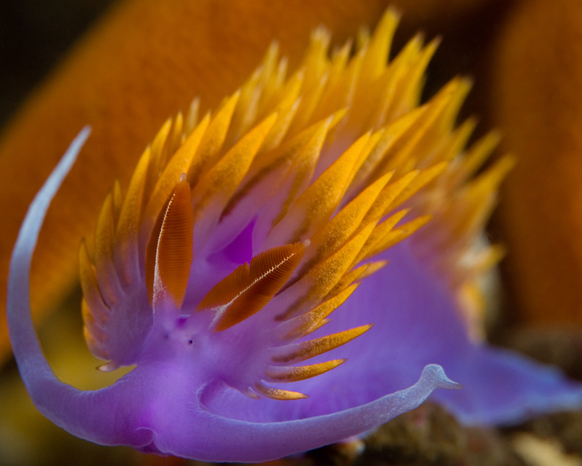
The vibrant colors of a Spanish shawl (Flabellina iodinea) provide
photographers with great raw material. Of course, there's always a catch: These
inch-long slugs flap violently in the surge like one of those cat toys made from
rubber bands on the end of a stick. As such, getting the rhinophores in focus is
often an exercise in frustration. Even a really good macro lens has difficulty
autofocusing on this type of subject. This shot was taken using a fixed focus
and fine movements of the photographer's hand to achieve focus by moving the
entire camera forward and backwards. The blurry orange arms are those of a blood
star (Henricia leviuscula).
"Shale Island", Monterey Bay, California
February 17, 2007
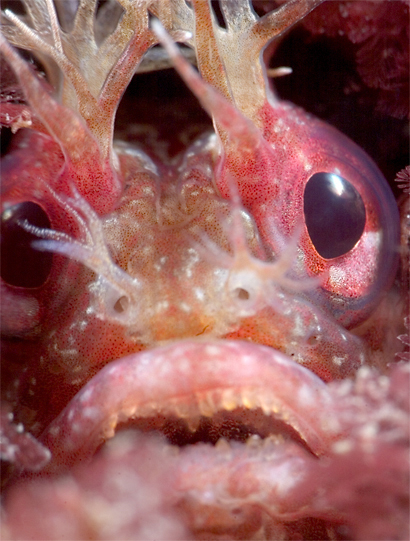
Yellowfin fringeheads (Neoclinus stephensae) have the best coiffure on
the reef. This animal has chosen a conspicuous patch of reef in which to make
his home. As such, it's easy to find. I usually drop by if I'm in the
neighborhood. As with most fringeheads, it's an almost sure bet that it'll be
home. This consistency peaked my curiosity. I wondered if these fringeheads are
exclusively ambush predators or if they sneak out under cover of darkness to
find themselves a meal. Naturally, I paid a visit one day at about one AM. The
hole appeared empty, but to be sure, I illuminated its interior. What I saw was
one perturbed looking eye and a big head of hair withdrawn well into the bore.
Oops! Sorry man.
"Shale Island", Monterey Bay, California
March 19, 2006
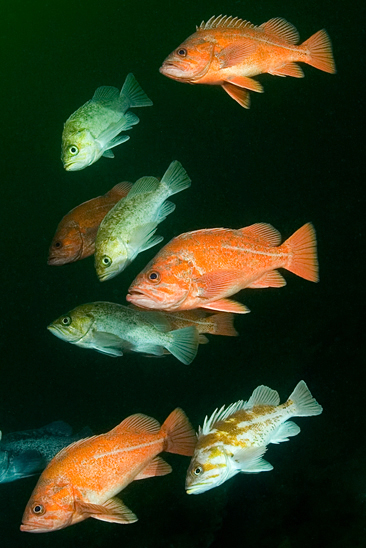
Vermilion (Sebastes miniatus), kelp (S. atrovirens), and copper
(S. caurinus) rockfish just kind of hanging out. Rockfish spend a lot of
time doing this, usually around some place that has shelter from predators. This
aggregation is right above a deep, but narrow recess in the shale substrate.
It's plenty big enough for any of these fish, but still far too small for the
likes of the resident harbor seals.
"Shale Island", Monterey Bay, California
August 27, 2006
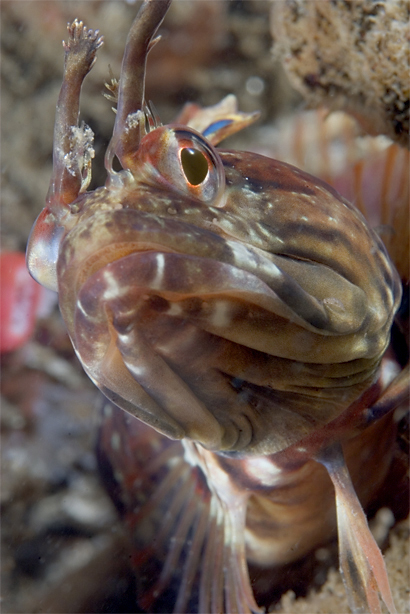
An unusually cooperative onespot fringehead (Neoclinus uninotatus) poses
for a portrait. These fish are seldom seen out in the open. Usually they tuck
everything but their head into a hole where it can't be seen. You can imagine my
surprise when I stumbled across a pack of onespot fringeheads hunting out in the
open. The group made attempts to eat just about everything in sight. Shrimp,
several nearby ronquils, even rocks if they even vaguely resembled something
more animate. I suspect that the shrimp were the menu item of choice. Certainly,
the little crustaceans were quick to vacate their holes when a fringehead
approached. More definitive proof was a red and white banded shrimp antenna
dangling from the mouth of one of the hunters. Surprisingly, a full mouth didn't
prevent this fish from seeking out additional prey.
"Shale Island", Monterey Bay, California
March 4, 2006
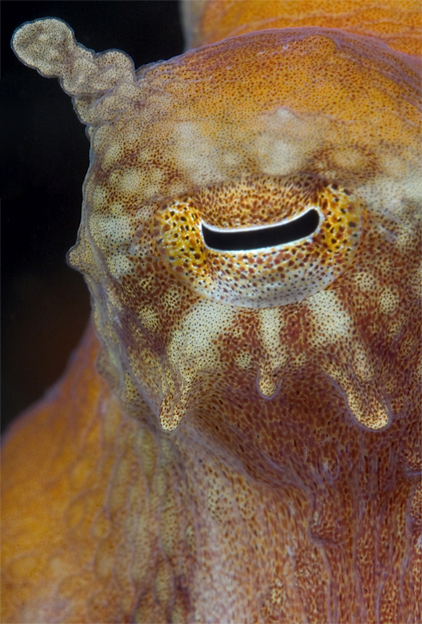
Few creatures appear as other-worldly as octopuses. One of many puzzling
postures red octopuses (Octopus rubescens) assume involves periscoping
their eyes like this.
"Shale Island", Monterey Bay, California
February 11, 2006
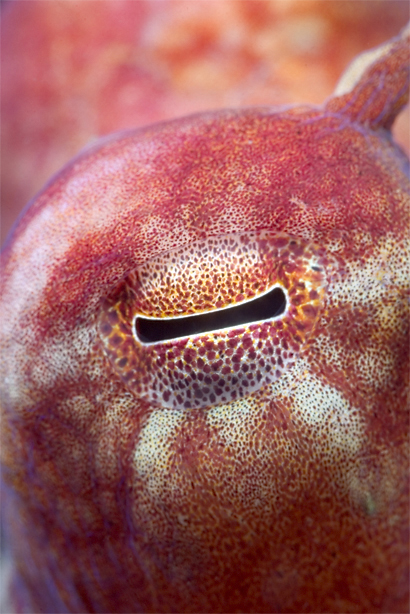
I find the rectangular pupils of octopuses a little hypnotic. It's hard not to
assume some intellegence is at work behind eyes like these. While generally
considered nocturnal and inhabitants of sandy areas, red octopuses (Octopus
rubescens) such as this one are commonly seen during the day in areas with a
shale bottom.
"Shale Island", Monterey Bay, California
April 9, 2006
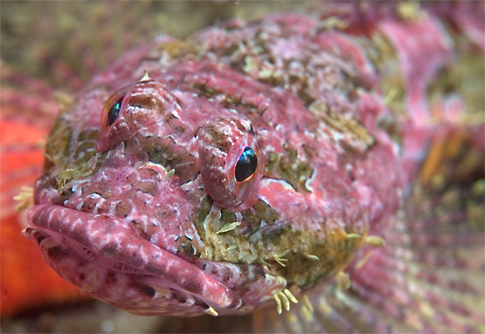
Coralline sculpins (Artedius corallinus) have a great crocodile smile.
"Shale Island", Monterey Bay, California
April 1, 2006
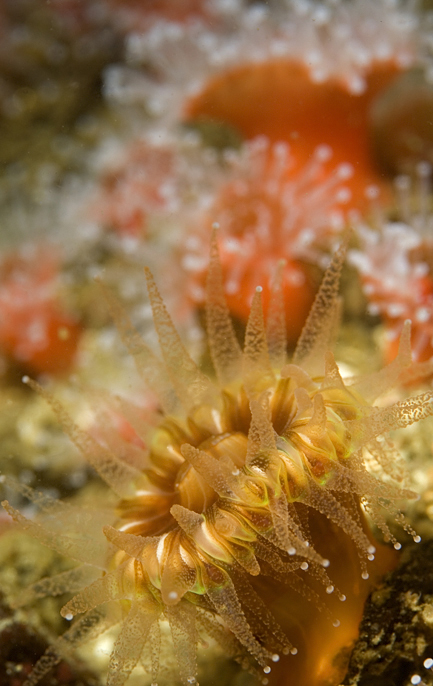
Brown cup coral (Paracyathus stearnsi) with club tipped anemones
(Corynactis californica).
"Shale Island", Monterey Bay, California
July 15, 2006
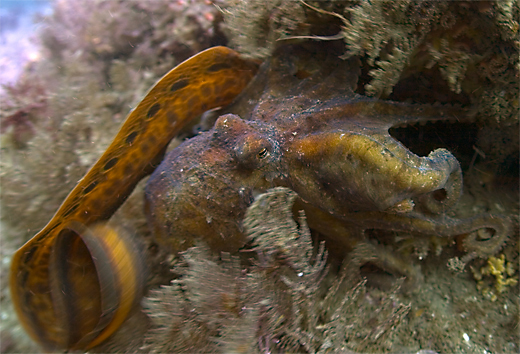
This red octopus (Octopus rubescens) is getting the best of a juvenile
wolf eel (Anarrhichthys ocellatus). It's a sure testament to the
octopus's success as a camouflage artist that it took me a good long time to
understand what was going on here. If I recall, the stream of consciousness went
something like "Huh, that's odd, why is that little wolf eel sticking its head
in a hole . . . and why is it assuming such an odd posture?". After a little
more inspection, "Hey, that wolf eel is eating an octopus!". It took quite a bit
more time to figure out who was really in control. In fact, I wasn't entirely
sure until after I separated the two participants, revealing the wound the
octopus had inflicted.
"Shale Island", Monterey Bay, California
May 22, 2005
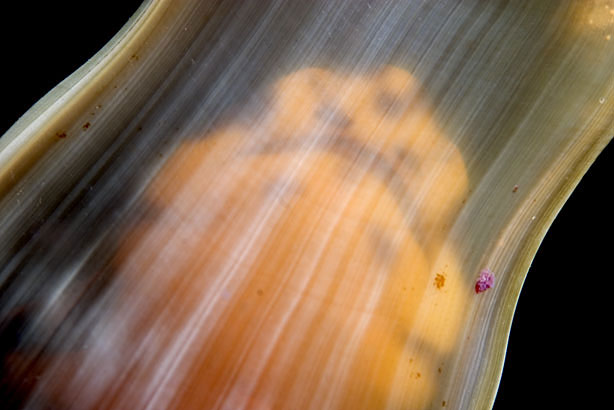
Visible through the walls of its egg case, this palm-sized swell shark
(Cephaloscyllium ventriosum) appears ready to hatch. Often called
"mermaid's purses", shark and ray egg cases are secured to the bottom using a
variety of mechanisms. This one had cork-screwed filaments which connected it to
a clump of algae.
"Shale Island", Monterey Bay, California
March 25, 2006

Home
